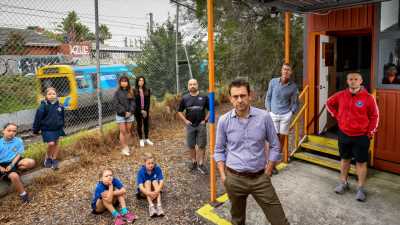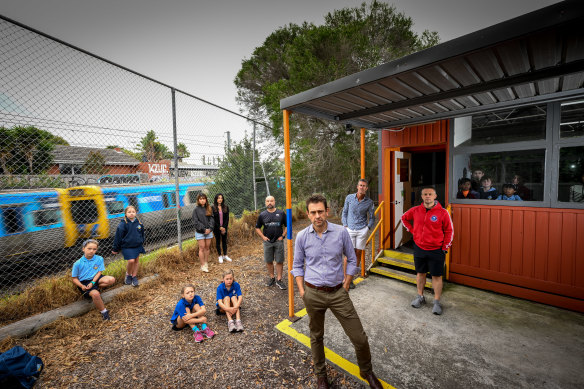Brighton Primary students learn in ‘tiny, crummy portables’ but state funding proves elusive

Brighton Primary School presents an impressive facade to the community.
A grand heritage building faces the street, built from sturdy brick almost 150 years ago, gothic windows flanking the arched entranceway.
Students at Brighton Primary School learn in ageing portables. The school community, led by council president Andrew Campbell (centre), has developed its own master plan for a rebuild.Credit: Eddie Jim
But at the rear end of the school, it’s a much more modest scene.
Fourteen ageing portables run in two facing rows. Poky, poorly insulated and full of asbestos, they are where two-thirds of the school’s 550 students learn each day.
The classrooms closest to the Sandringham railway line are also regularly disturbed by train noise.
“Parents rock up and think, ‘this is nice, wonderful old buildings’, but the reality is that for most of their schooling kids are in these tiny, crummy portables,” school council president Andrew Campbell says.
Like all state schools, Brighton Primary depends on government funding for capital works.
But come state budget time, it has been overlooked year after year, despite what it believes is a compelling case.
The school community’s frustration is compounded by the fact that every other government primary school in Melbourne’s bayside region has received capital funding in the past six years.
Twenty-one primary schools that line the bay between Port Melbourne and Beaumaris have received a combined $195 million from the Victorian School Building Authority between 2016 and 2022, analysis shows.
Grants have ranged from $44 million for the new South Melbourne Primary to $200,000 each for minor works at St Kilda Park and Cheltenham primaries at the bottom end.
Brighton Primary has received $0.
Campbell said the school was mystified by its exclusion.
“What I don’t understand is the tattslotto of funding decisions. There is no obvious pathway to securing capital investment in a school.”
The school has decided to be “a squeaky wheel” in the hope of getting an elusive capital grant, Campbell says.
Parents recently contributed $13,000 to commission an architect to create a master plan for a school modernisation project. The vision was presented to the school building authority, despite its advice not to go down that road.
Campbell said Brighton Primary was inspired by the experience of Sandringham East Primary, which did the same thing and subsequently won $23.6 million in capital funding.
Other schools with run-down facilities have used similar attention-seeking tactics to try to pressure the government to fund an upgrade.
In October last year, on the cusp of the state election, families from Sunshine College in Melbourne’s west released a short film on YouTube exposing the school’s derelict north campus.
Two students gave viewers a tour of a building with gaping cracks in the walls, a collapsing ceiling, rotted benchtops and foul-smelling toilets infested with black mould.
It was professionally produced, right down to the Tchaikovsky waltz for a soundtrack. It was also damning enough to lead to a meeting with the education minister and the chief executive of the school building authority, though the college is still waiting for a commitment on capital funding, six months later.
Victorian Principals’ Association president Andrew Dalgleish said the selection process for capital funding lacks transparency.
“We would love to see a clear formula based on school need, on assessments of school facilities,” Dalgleish said.
Instead, government schools are routinely left in suspense about when and how their turn will come, he said.
“It becomes really frustrating for school communities when they feel that they’re missing out. Schools would love to see a transparent approach to identifying and then receiving funding for capital works.”
The Department of Education said its ongoing responsibility was to balance the needs of more than 1570 government schools, taking a long-term view for capital works and prioritising funding for schools that are in poor condition or in areas of high population growth.
“The infrastructure needs of all schools, including Brighton Primary School, are considered through the state budget process,” a spokesperson said.
“We use all available information, including condition assessments, enrolment projections, and pre-existing project plans to determine funding priorities.”
The Morning Edition newsletter is our guide to the day’s most important and interesting stories, analysis and insights. Sign up here.
Most Viewed in National
From our partners
Source: Read Full Article
